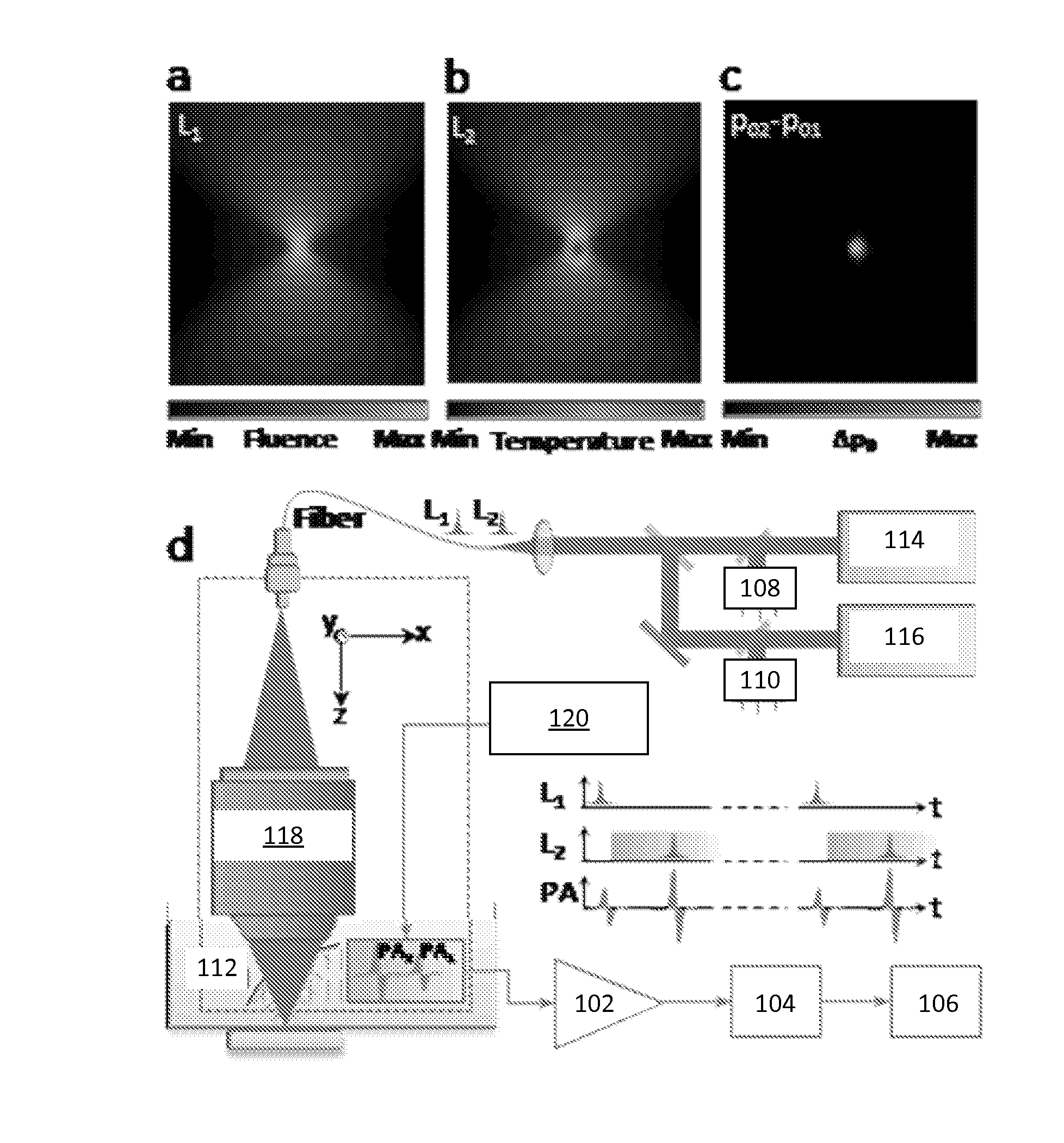Systems and methods of grueneisen-relaxation photoacoustic microscopy and photoacoustic wavefront shaping
a technology of photoacoustic wavefront and relaxation, applied in the field of systems and methods for improving photoacoustic resolution, can solve the problems of insufficient sensitivity of non-radiative absorption contrast images, lack of optically defined axial resolution of confocal microscopic images,
- Summary
- Abstract
- Description
- Claims
- Application Information
AI Technical Summary
Benefits of technology
Problems solved by technology
Method used
Image
Examples
example 1
The Grueneisen-Relaxation Effect
[0092]The Grueneisen-relaxation effect was experimentally validated by imaging red blood cells (RBCs). A monolayer of RBCs was fixed on a glass slide, immersed into deionized water, and positioned in the optical focal plane. Multiple PA images were acquired using two-dimensional raster scanning. At each measurement, the PA amplitude was calculated from the average signal of the entire PA image.
[0093]First, the linear relationship was validated between the single-pulse PA amplitude and the excitation laser pulse energy. To avoid the Grueneisen-relaxation effect, only one laser was triggered at 10 kHz. Laser energy was set from 0 to 60 nJ. FIG. 2a shows that the single-pulse PA amplitude was proportional to the laser pulse energy.
[0094]Then the Grueneisen-relaxation effect was experimentally demonstrated using two lasers that were sequentially triggered with a 500 ns delay. ΔPA2=PA2−PA2_0. PA2 was the second PA amplitude, whereas PA2_0 was the second PA...
example 2
Measurement of Lateral and Axial Resolutions
[0096]Lateral resolution was measured by imaging a sharp ink edge on a cover glass. The edge spread function (ESF) of the GR-PAM was obtained by scanning across the sharp edge (FIG. 3a). For comparison, the ESF of the OR-PAM was computed from the PA signal of the first laser pulses. Derivation of the ESFs gives the line spread functions (LSFs, inset in FIG. 3a). The FWHM of the LSF quantifies the lateral resolution. The lateral resolutions of OR-PAM and GR-PAM were 0.65 μm and 0.41 μm, respectively. Therefore, the lateral resolution was improved by a factor of 1.6, close to the theoretical prediction of √{square root over (2)}. In an aspect, the FWHM of the OR-PAM profile may be 45 μm.
[0097]Axial resolution was quantified by scanning perpendicularly to a monolayer of RBCs. At each axial position, the peak-to-peak amplitude of the differential PA signal was recorded to form a 1D depth-resolved image of the GR-PAM, which was fitted to a Gaus...
example 3
Optical Sectioning Imaging of Red Blood Cells
[0098]GR-PAM enables optical sectioning, improving the axial resolution. FIG. 4a, FIG. 4b, and FIG. 4c show GR-PAM images of a monolayer of RBCs placed at different axial positions. The average laser pulse energy was set at 25 nJ. As the RBCs moved out of optical focus, the GR-PA signals quickly decreased, demonstrating optical sectioning. FIG. 4d, FIG. 4e, and FIG. 4f present OR-PAM images of the same sample. The OR-PAM signals did not show obvious changes when scanning the sample along the axial direction. FIG. 4g and FIG. 4h present GR-PAM and OR-PAM side-view images in the x-z plane. With optical axial resolution, a small tilt angle of the sample slide was clearly imaged using GR-PAM. In addition to the improvement in the axial resolution, GR-PAM also enhanced image contrast. The doughnut-feature contrast was quantified as c=(PAmax−PAmin) / PAmax, where PAmin is the smallest pixel value in the doughnut feature, and PAmax is the nearest ...
PUM
| Property | Measurement | Unit |
|---|---|---|
| lag interval time | aaaaa | aaaaa |
| lag interval time | aaaaa | aaaaa |
| lag interval time | aaaaa | aaaaa |
Abstract
Description
Claims
Application Information
 Login to View More
Login to View More - R&D
- Intellectual Property
- Life Sciences
- Materials
- Tech Scout
- Unparalleled Data Quality
- Higher Quality Content
- 60% Fewer Hallucinations
Browse by: Latest US Patents, China's latest patents, Technical Efficacy Thesaurus, Application Domain, Technology Topic, Popular Technical Reports.
© 2025 PatSnap. All rights reserved.Legal|Privacy policy|Modern Slavery Act Transparency Statement|Sitemap|About US| Contact US: help@patsnap.com



